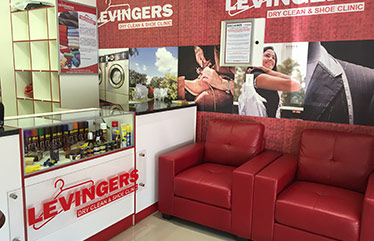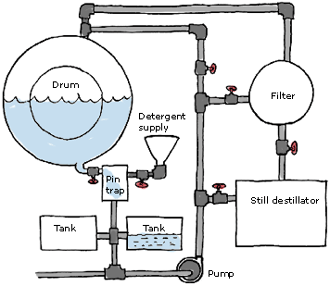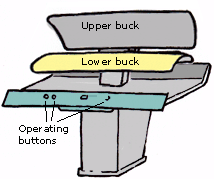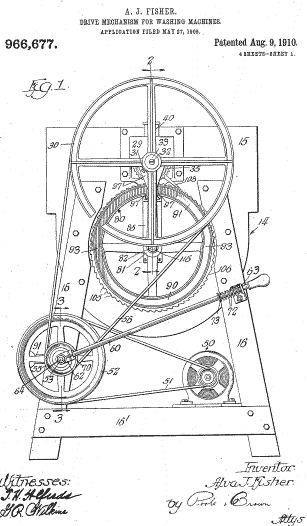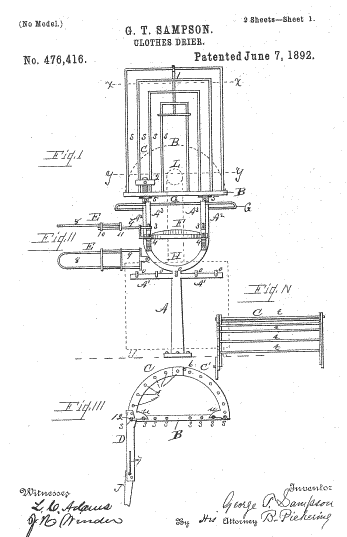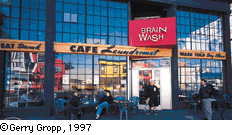News
How to Care for this Year’s Leather Trend
| Leather can be a seriously long-lasting fabric if treated properly. With correct care and attention, new leather can last to a ripe old age and any vintage leather you own can continue to have a long, happy life. Proper storage, cleaning, and conditioning will keep leather looking as good as new no matter how old it is. |  |
Storing Leather
- How leather is stored when it is not being used is very important. To keep it in its best condition, leather should not be stored in extreme hot or cold temperatures, or in excessive dryness or humidity. It also needs to be kept away from chemicals – whether in storage or when wearing.
- Store leather clothes on a wide wooden or padded hanger to help maintain their shape.
- If it is necessary to cover the leather whilst storing it, ensure that a breathable fabric, such as cotton is used. Do not cover leather clothing with plastic as it will cause the leather to dry out.
- Avoid exposing leather garments to direct sunlight for prolonged periods of time.
- It is important that leather does not become soiled, soaked or dried out, because whilst these can be rectified, it requires much more effort to do so.
- Always stuff empty leather handbags with newspaper and use shoetrees when storing leather shoes and boots.
Cleaning leather
- Keeping leather clean and conditioned only takes a few minutes, but it will make a big difference in how good it looks.
- Dry cleaning is an effective and efficient way of cleaning leather.
- Don’t let an item become too dirty before having it cleaned and point out any stains or ingrained soiling to the dry cleaner.
- Dry cleaning can sometimes cause a change in the depth of colour of a garment as some dyes are soluble in dry-cleaning fluids. Deluxe cleaning by LEVINGERS DRY CLEANERS provides a much kinder way of cleaning leather than traditional dry cleaning processes using PERC.
- Incorrect care or cleaning of leather can cause it to crack and dry out, as well as remove finishes or colours, or worse still, make it too stiff to wear.
- Continual contact with moisture (sweat, rain, alcohol, etc.,) can cause the leather to stiffen, so ensure that these are cleaned off the leather regularly.
Stains and smells on leather
- It is possible to remove most stains from leather even blood, oil and wax – speak to the professionals!
- Leather likes to hold on to odours, however a leather specialist or dry cleaner should be able to remove the smell.
Repairing damage to your leather
- If leather becomes scuffed the marks can often be disguised by applying a shoe polish/leather dye or marker pen.
- Any broken stitching is best repaired with a heavy-duty sewing machine. LEVINGERS DRY CLEANERS provides professional leather cleaning and repair services.
- Several types of leather require more specialised maintenance. If in doubt, have leather cleaned and maintained professionally.
Top Tips on caring for your woollens, cashmere & mohair knits
Cleaning jumpers
- The best method of washing cashmere or wools is through dry cleaning. LEVINGERS DRY CLEANERS provides the gentlest way of doing this.
- Handwashing wools and cashmere will cause a thickening of wool over time which will ultimately misshape your jumper to the point where it will no longer fit you.
Storing jumpers
- Store jumpers folded on a shelf, rather than hanging on a hanger as the shoulders will become misshapen over time.
- Ensure that the jumpers are dry before storing them – failing to do this can cause mould and provides a great environment for moth larvae to incubate.
- Make sure you only store your jumpers clean – moth larvae feed from unseen proteins (hair, skin and residual perspiration) that are left on the garment.
Protecting jumpers from moths
- Moths love cashmere, mohair and woollen jumpers – protect them in a wardrobe through use of natural moth repellents such as cedar balls and lavender oil sachets.
- If you find that one jumper has succumbed to moth damage, it is likely that other jumpers in your wardrobe might follow suit. The best course of action is to dry clean all other jumpers immediately and vacuum the wardrobe to clear it of any eggs.
- Sometimes moth damage is not noticed until after cleaning a garment as the process will remove the broken fibres caused by the larvae munching through the fabric.
- From time to time shake out your jumpers to deter any moth larvae from settling.
Removing stains from jumpers
- If you accidentally spill red wine (or anything else) on your jumper – do nothing! Instead take it to be dry cleaned as soon as you can. Rubbing or dabbing the stain will ingrain it further into the fibres making it harder to remove.
Think Your Coat is Clean? Think Again!
- Almost half of the nation clean their coats once a year or less.
- Just one in ten people dry clean their winter outerwear the recommended once a month.
- 13% would rather buy a new coat altogether than take theirs to be cleaned.
As the country braces itself for the winter, LEVINGERS DRY CLEANERS has revealed that almost half of the nation clean their coats once a year or less and more than one in ten of us prefer to buy a new coat than have a weathered one cleaned. Prem Bhaktawer, a Cleanologist at LEVINGERS DRY CLEANERS, gives us his top tips for keeping your outerwear in best condition come rain…or snow:
1. Macs and trench coats are the most versatile of coats, but with frequent wear comes marks and stains. Over time, the classic light, cream bonded cotton can become dull. If you spot a mark, blot it immediately with a damp sponge to lift dirt from the surface. Never rub or scratch the mark as this will ingrain it into the fabric weave.
2. Not only should a wool coat be kept clean, but much like your hair natural fibres need to be well groomed too. Brush your coat with a soft-bristle brush every other wear to keep the fibres in shape. This will also help dirt from bonding to the fabric.
3. Treat water marks with steam. If you’re caught in a downpour and your coat is splattered with rain marks, use the steam setting on your iron to gently evaporate any signs of residue. You can double up by taking creases out of the fabric as well.
4. Leather is robust, but needs to be looked after. The common mistake is to leave leather outerwear to dry by a radiator or other heat sources, but this can dry out the natural oils, which are crucial for keeping the surface supple and water repellent.
Five reasons to clean your wedding dress after the big day
# 1
For most brides, your wedding dress is the most expensive garment you have ever worn and that’s why it deserves the best treatment; after all it’s such a precious keepsake of your special day. With LEVINGERS DRY CLEANERS your wedding dress is professionally cleaned and hand finished by our expert team. Plus with LEVINGERS DRY CLEANERS it couldn’t be easier, all you need to do is bring the items in for a DELUXE service.
# 2
In a recent survey we found that 52% of brides choose to keep their wedding dress after their big day, stored in their wardrobe or loft. In order to prevent damage, fading and discolouration before storing your wedding dress it is important your dress is cleaned. The longer your dress is left with the remains of your wedding buffet, spills from the toasts and mud marks from your photographs, the more difficult they are to remove and the more damage they can do to the fabric of your dress.
We care for thousands of dresses every year, meaning we have experience delivering beautiful cleaning results working with specialist fabrics, dress construction and wedding dress accessories.
# 3
LEVINGERS DRY CLEANERS clean exclusively using DELUXE a gentle alternative to harsh chemicals used by other dry cleaners that is ideal for the delicate fabrics and detailing found on wedding dresses. Cleaning solutions used by other dry cleaners can remove anything from embellishments and sequins whilst vastly changing the shape of your dress and risking shrinkage.
# 4
Your dress gets the VIP treatment with LEVINGERS DELUXE Bridal. All our dresses enter our specialist wedding dress clean room where cleaning and finishing equipment is exclusively used for wedding dresses. Before cleaning, each wedding dress is taken into our UV chamber which highlights all the marks on your beloved dress, even ones that the naked eye can’t see. Champagne is a common culprit here, yellowing fabrics years later if it isn’t discovered and correctly cleaned.
# 5
Your wedding dress goes through it all on your wedding day, red wine spills, chocolate from your fondue and fake tan, of course the marks are memories but not something you want to see again. LEVINGERS DRY CLEANERS is the perfect solution to preserve your wedding dress, allowing you to treasure your memories of your big day for years to come.
Some amazing facts about leather
Fact 1 – Leather Out Fabric-Four-to-One
Leather is 50% stronger than other upholstery and could have a useful life of 15-20 years.
Fact 2 – Leather Offers year Round Comfort
Leather “breathes” so it stays cool in the summer and warm in the winter.
Fact 3 – Leather is Extremely Durable
Strong enough to resist tearing, even along the seam lines. leather has natural oils that prevent cracking, floating, tearing or pealing.
Fact 4 – Leather Ages Well
Leather is very flexible, so if strains the shape and look for years. Plus unlike fabric, it acquires a natural patine and becomes softer with age.
Fact 5 – Leather Color Stays Vibrant
Each leather hide is completely immersed in dye until it penetrates all the way through to create a deep, rich color that will remain beautiful throughout the life of the leather.
Fact 6 – Leather is Easy to Care For
Ideal for any lifestyle, leather simply requires a mild dusting or wiping to keep it looking good.
Latest Store Openings
Why’s And How’s Of Dry Cleaning
How Dry Cleaning Works
Dry-cleaning has long been the only alternative to traditional washing. There are several reasons for using dry-cleaning: Water-sensitive materials; Some linen cannot be washed in water; Some materials are very sensitive to water, and are thus often dry-cleaned, although today, wet-cleaning is a competitive alternative to dry-cleaning in some countries; Textiles with water-based colours may readily be dry-cleaned. Shrinkage Garments made from water-sensitive materials are often dry-cleaned to avoid or reduce shrinkage Preserved quality Dry-cleaning provides shape permanence and high finish. Folds and pleats are not damaged, while linings and the like will keep their stiffness. Furthermore, the risk of discolouration is normally negligible. NOTE: Materials containing PVC may be harmed during dry-cleaning. Solvents and the environment Today, two different solvents are in use for dry-cleaning: perchlorethylene (perc) and hydrocarbon. The timetable below shows the use of dry-cleaning solvents during the 20th century.
1950 The chemical used for dry-cleaning was white spirit 1960 Perc comes into use. It is a highly efficient chemical, although it harms plastic details. 1970 The chemical 113 is put into use for dry-cleaning delicate materials, thus complementing perc. 1990 113 is forbidden as it is discovered that the chemical damages the ozone layer. Instead, white spirit is refined, resulting in hydrocarbon. The Dry-Cleaning ProcessOne machine cleans and dries A dry-cleaning machine is basically a machine with built-in extraction and drying. A solvent other than water is used: most often perchlorethylene (perc). The solvent will remove fats and grease far more efficiently than a normal water/detergent liquid. Adding water However, the effect on water-soluble dirt and solid dirt is very low or even negligible. Consequently, to achieve an acceptable result, water must be added to the process. The water-adding procedure is, however, not quite so straightforward. If pure water was added, the result would be bodies of water unevenly spread on the solvent surface. The washing result would not be satisfactory. To spread the water evenly over the whole solvent surface, a detergent must be added to the water. Dry-cleaning detergents work in much the same way as water washing detergents, but are quite differently composed. The cleaning procedure includes:
The solvent Perc The most common solvent used to remove fats and grease is perc. Unfortunately, though, it is regarded as less friendly to the environment. The use of perc is the main drawback of the dry-cleaning process, and has recently caused alternative washing systems to be developed. Today, dry-cleaning remains the most common alternative to traditional washing. How Dry-Cleaning Works The illustration below describes the dry-cleaning process in a simplified way. Please note that a great number of different procedures exist on the market, and a certain method is very often connected to a manufacturer.
Drying process After extraction, the garments are dried by circulating hot air. The hot air blows onto the garments to remove most of the residual perc. This procedure is normally called deodorisation. The exhaust air from the machine contains some solvent, so it must pass an activated carbon filter before being transported into the open air. The evaporated solvent is separated from the air and fed to the distiller tank. The air circulates until no more solvent can be removed. Dry Cleaning Finishing & PressingTwo major steps The finishing process after dry-cleaning is divided into two major steps: first the garments are conditioned, then pressed. Conditioning The garments are conditioned, ?de-wrinkled?, on a steam air finisher. Different finishing-machines are used, depending on the type of garment. The dry-cleaning process utilises the following equipment for conditioning
Pressing Once the garment is conditioned, it is pressed. This is when the final appearance is achieved – creases are formed, seams, hems and panels are pressed. When finishing dry-cleaned garments, scissor presses and professional finishing tables are used. Spotting tables The spotting table is used to remove stains. Spotting tables always have a vacuum, both to draw through the liquid and hold the fabric in place. Generally, stains are removed before dry-cleaning in a pre-spotting process. During dry-cleaning, water-based stains and other difficult stains such as blood and ink will be removed. Spotting can also be done after dry-cleaning. This is called post-spotting. At this point, water-based stains and stains which were not discovered before the dry-clean will be removed. ?Post spotting? is usually carried out with a steam or water gun. Afterwards, the fabric is dried with an air gun. NOTE: Some stains not removed prior to dry-cleaning can sometimes be made more permanent during the cleaning process. Pressing Removes creases Soften the fabric.
Pressing can be carried out in a number of different ways depending on the type and quantity of items to be pressed. Small volumes of linen are most economically pressed manually, using a hand iron and an ironing table. A skilled person can hand iron up to 20 cotton shirts per hour.
Press bucks There are a variety of press bucks available – each buck is specifically made to fit a certain type or even a part of a garment. There are bucks suitable for collar and cuffs, trouser legs and tops etc. However, the most popular is a general purpose utility shape. Presses are mostly used in large on premises laundries and commercial laundries.
How press bucks works
Professional finishing table All garments can be pressed with a professional finishing table. This is equipped with an ?all steam iron? which is safe to use on dry work. A good hand steam iron is always supplied with a Teflon shoe which protects the garment. The large table always has vacuum which will hold the fabric in position on the table. The vacuum will also cool the garment after pressing. The vaccuum is also necessary for pressing light-weight fabrics and linings. Cleaning Labels All garments should have a cleaning label which indicates how the garment should be cleaned. It is important to Pay attention to the instructions and treat the garment accordingly. For a list of these labels go back to the main Menu to ?Cleaning Guides?.
|
A Brief History of Dry Cleaning
Drycleaning dates back to ancient times, probably beginning with the advent of textile clothing itself. The ruins of Pompeii gives a record of a highly developed trade of *fullers* who were professional clothes cleaners. Lye and ammonia were used in early laundering, and a type of clay known as *fuller*s earth* was used to absorb soils and grease from clothing too delicate for laundering.
There are many stories about the origin of drycleaning, all centering on a surprise discovery when a petroleum-type fluid was accidentally spilled on a greasy fabric. It quickly evaporated and the stains were miraculously removed. The firm of Jolly-Belin, opening in Paris in the 1840s, is credited as the first drycleaning firm.
Solvents
In spite of the name, drycleaning is not completely dry. Fluids are used in the drycleaning process. In the early days, garment scourers and dryers found several fluids that could be used as drycleaning solvents, including camphene, benzene, kerosene, and gasoline. These fluids are all dangerously flammable, so drycleaning was a hazardous business until safer solvents were developed.
In the 1930s, percholoroethylene or *perc*(a nonflammable, synthetic solvent) was introduced and is used today in many drycleaning plants. Other cleaning solvents have been added, and still others are currently being tested.
LEVINGERS offers professional dry cleaning to the most superior labels in the world.


